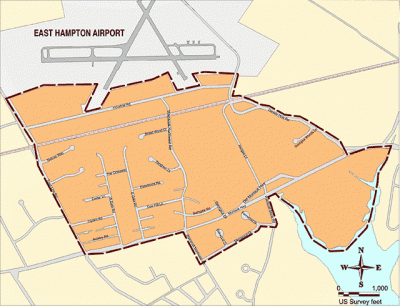Contaminants Found in Drinking Water Near East Hampton Airport

Suffolk County Health Department officials testing water from private wells in the area of the East Hampton Airport have found levels of two perfluorinated chemicals at one residence in excess of the Environmental Protection Agency’s acceptable levels for lifetime exposure to avoid adverse effects.
The State and County Health Departments want to sample all private wells in an area bounded on the north by the airport, on the west by Town Line Road, on the east by Daniel’s Hole Road, and on the south by Montauk Highway and Merriwood Drive.
As a precaution, East Hampton Town has offered to provide free bottled drinking water to all those in the test area who are not connected to Suffolk County Water Authority public water supplies, which are regularly tested.
Perfluorinated chemicals, or PFCs — considered an “emerging contaminant” by the E.P.A. and a potential danger to health — include a number of compounds used in manufacturing to make products resistant to stains, grease, and water. They are used in firefighting foams and other materials, and in the aerospace, automotive, construction, and electronics industries because of their friction-reducing properties.
According to the E.P.A., studies on animals indicate that exposure to two PFC compounds — perfluorooctane sulfonate (PFOS) and perfluorooctanoic acid (PFOA) — over certain levels may negatively impact fetuses and breastfed infants, affect the thyroid, liver, and immune systems, and cause cancer, among other effects.
A survey by the State Department of Environmental Conservation of facilities where products containing PFOS and PFOA may have been used led to the well-testing program after it was revealed that such products had been used at the airport.
Town Supervisor Larry Cantwell yesterday advised residents approached by the Health Department to allow their wells to be tested, which will be done free of charge. Once more information is compiled, he said, the D.E.C. may investigate the source of the contamination, and, if necessary, plans could be made to have affected residents hooked up to public water.
In the meantime, those in the test area can arrange for bottled water deliveries by contacting the town’s Purchasing Department by phone or by sending an email to [email protected].
To begin to determine if there are other possible areas of contamination in the town, Mr. Cantwell said he has asked the fire marshal to collect information from fire departments regarding whether they have used firefighting foam, or if they have any on hand.
The chemicals in question are currently unregulated by the federal government, but the Environmental Protection Agency has established informational-only health advisories for PFOS and PFOA and is working to help states and public water providers take steps to reduce exposure to them in drinking water. Under the Safe Drinking Water Act, water providers are required to monitor for them.
The E.P.A.’s health advisories are nonregulatory and designed “to provide information on contaminants that can cause human health effects and are known or anticipated to occur in drinking water,” according to a fact sheet by the agency.
To provide “a margin of protection from a lifetime of exposure to PFOA and PFOS from drinking water,” the E.P.A. has set a combined level of 70 parts per trillion of the two chemicals as a maximum safe level in water.
The health advisories do not address exposure to the chemicals from skin contact, breathing, or other sources of exposure beyond drinking water. In January 2016, the Food and Drug Administration banned use of the two compounds in food packaging.
Research is ongoing by agencies including the National Institute of Environmental Health Sciences and the National Toxicology Program on the potential health effects of exposure to them.
In April 2016, PFOS was added to New York State’s list of hazardous substances in connection with the Superfund cleanup program.
The discovery of PFOS in public water supply wells in the vicinity of the Air National Guard Base at Gabreski Airport in Westhampton Beach, traced to the firefighting foam used at the base, led the state to declare the area a Superfund site last September.
Several hundred residents exposed to the chemical sued the county and state, pointing to serious health conditions suffered by people in a wide number of households surrounding the base. They asked to be provided with ongoing blood testing to monitor health risks, which the State Health Department last winter agreed to provide.
The Department of Defense was required to undertake a cleanup and to pay for nearby residents with private wells — those where contamination was found and those that could be impacted — to hook up to public water mains. Bottled water was supplied, and the public water supply was treated to remove the contamination. Treatments such as reverse osmosis, or with activated carbon, can be used to remove PFOA and PFOS from drinking water, according to the E.P.A.
In a press release yesterday, the County Health Department asked residents in the delineated testing area to call the Department’s office of water resources at 631-852-5810 to arrange for water testing. Those with questions about PFCs and their health effects may visit the Health Department website at suffolkcountyny.gov/health or call the New York State water quality hotline at 800-801-8092. Those unsure if they have private wells or are served by public water may call the Suffolk County Water Authority at 631-698-9500.
